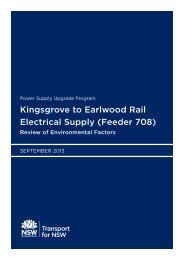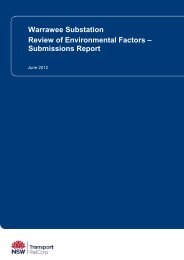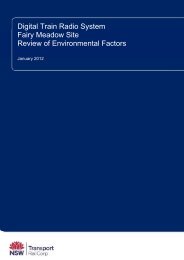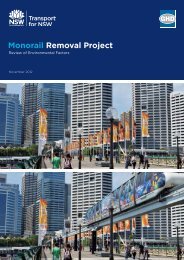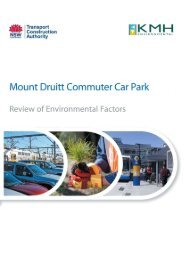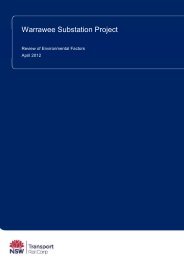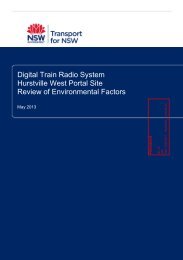Digital Train Radio System Como Site Review of Environmental ...
Digital Train Radio System Como Site Review of Environmental ...
Digital Train Radio System Como Site Review of Environmental ...
You also want an ePaper? Increase the reach of your titles
YUMPU automatically turns print PDFs into web optimized ePapers that Google loves.
• Multimeter<br />
• Hand digging tools (shovels etc).<br />
• Electrical hand tools<br />
The use <strong>of</strong> a crane is further detailed in the <strong>Site</strong> Safety Management Plan and its location<br />
indicated on a crane map - both are part <strong>of</strong> the project documentation.<br />
The skip bin and the site compound area will be located within the rail corridor near the site. The<br />
construction process will require an average <strong>of</strong> six vehicle movements and a team <strong>of</strong> three to<br />
six people on site per day.<br />
3.3 Timing and Costing<br />
Construction works for the proposal is planned to start in the first quarter <strong>of</strong> 2012 and scheduled<br />
to run for a period <strong>of</strong> six weeks<br />
Proposed construction timing:<br />
Standard working hours<br />
Evening/Weekends/Out <strong>of</strong> hours:<br />
Monday to Friday 7.00am to 6pm<br />
Saturday 8.00am to 1.00pm<br />
No night works or out <strong>of</strong> hours works proposed<br />
No work on Sundays/public holidays<br />
The DTRS project has an overarching value <strong>of</strong> $225 million. This includes the design, supply,<br />
and installation <strong>of</strong> the DTRS on the RailCorp electrified network plus a five-year life support<br />
component.<br />
3.4 Alternatives to DTRS<br />
As discussed earlier, the Waterfall Special Commission <strong>of</strong> Inquiry precipitated the<br />
recommendations regarding communications in NSW rail operations and within RailCorp. The<br />
NSW Government then committed to a state-wide strategy for all rail communications.<br />
RailCorp investigated a number <strong>of</strong> alternatives already used by the state government or<br />
available commercially, looking for a system that met its own safety and reliability requirements<br />
as well as the recommendations <strong>of</strong> the Waterfall inquiry.<br />
The government alternatives were the existing MetroNet system or the Government <strong>Radio</strong><br />
Network (GRN).<br />
The existing MetroNet communication system was not deemed a feasible solution for the<br />
reasons listed below.<br />
• It uses out dated technology and cannot be expanded due to its limited capacity.<br />
• It does not have the ability to support the requirements <strong>of</strong> Automatic <strong>Train</strong> Protection.<br />
• It only has one main supplier and this, combined with obsolete technology, means the<br />
cost <strong>of</strong> using and maintaining the MetroNet system is increasing at a substantial rate.



